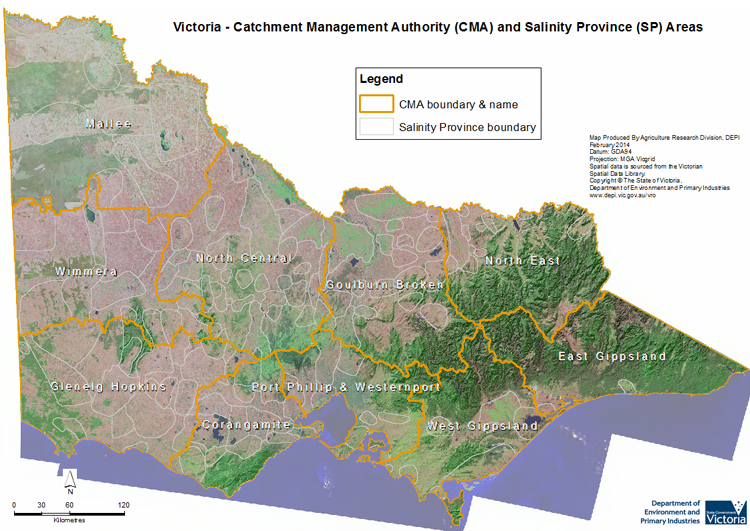What are Salinity Provinces?
Salinity Provinces (SPs) provide a framework for describing land and water (both surface and groundwater) salinity in Victoria. These are specific geographic areas where the landscape setting and physical processes contributing to salinity are similar, and where salinity management options are also similar. Each Province contains discrete salinity impacted areas where there is a concentration or higher incidence of land and/or water salinisation, which may or may not have been mapped. This may be "primary" or "secondary" salinity, the development of which can be explained by a particular landscape setting, groundwater process or most commonly, Groundwater Flow System(s) (GFS(s)).
The soil salinity mapping used to help delineate the SPs does not cover the Irrigation Regions of the State. In these areas, 'depth to watertable' and 'watertable salinity' mapping has been used to convey the threat of high watertables on soil waterlogging and/or soil salinisation. This information is yet to be included in the individual SP pages but links to existing maps have been added where appropriate.
History of the 'Salinity Provinces' concept
P. Macumber and C. Fitzpatrick of the former Department of Water Resources (Victoria) first introduced the concept of 'Salinity Provinces' in Victoria in a 1986 report. This report titled 'Salinity in Victoria: Physical Control Options' defined 14 'Salinity Provinces' distinguished by their distinctive hydrogeological and geomorphic characteristics. For each province, groundwater characteristics, salinity trends, control options and research and investigation needs were described.
In 2010, the Department of Primary Industries re-visited the 'Salinity Provinces' concept as a way of categorising salinity occurrence, risk and management options across Victoria. Out of this work was the delineation of the 140 'Salinity Provinces' described on these web pages.
Victoria's Catchment Management Authorities (CMAs)
For the purpose of environmental asset management, Victoria has been divided into 10 major Catchment Management Regions (CMRs), each covering the area of one or more of the major surface catchments in the state. Catchment Management Authorities (CMAs) manage the environmental assets in each of these regions. The Salinity Provinces have been divided according to the CMA region in which they are located.
Salinity Province Locations and Details
Clicking within a CMA area on the map below will link to a page displaying a description of the CMA, including the general nature of the occurrence of salinity within that CMA, and it's Salinity Provinces. These pages also include a map of each CMA displaying the location of its Salinity Provinces and a table listing some of the details of each Province. Clicking within a particular Salinity Province on this CMA map will in turn link to a page providing salinity information, a map, and a table listing some other 'attributes' specific to that particular Salinity Province.
Victorian CMAs and Salinity Provinces Map
Click within a CMA to access more detailed information and a map of that CMA.




